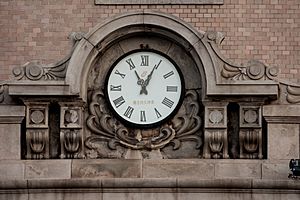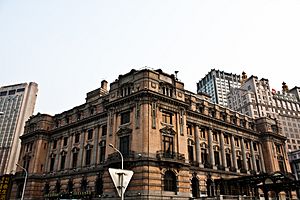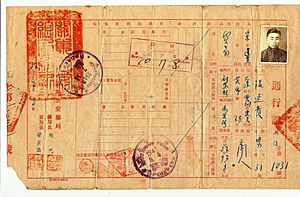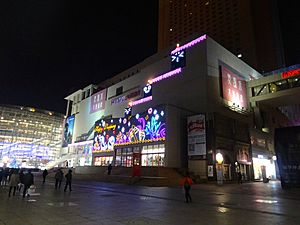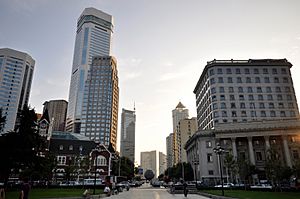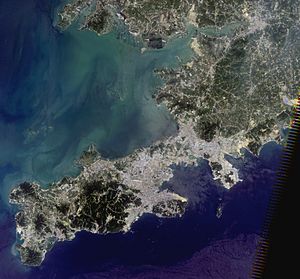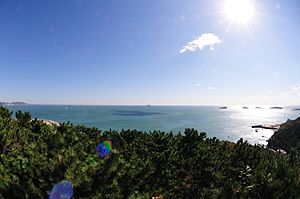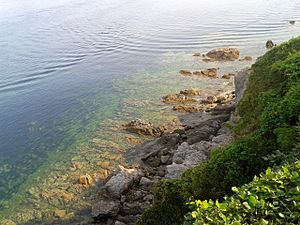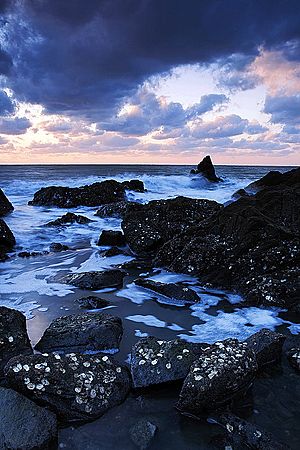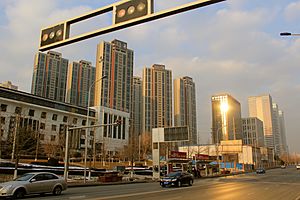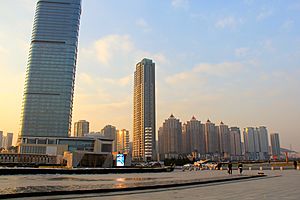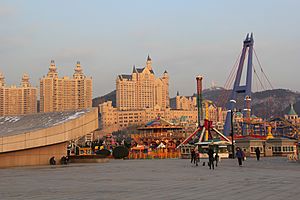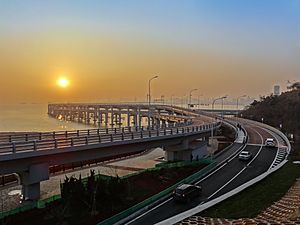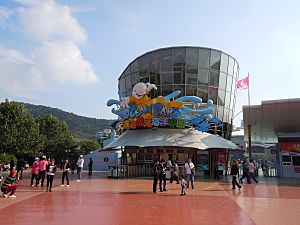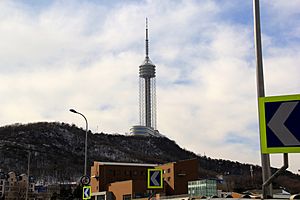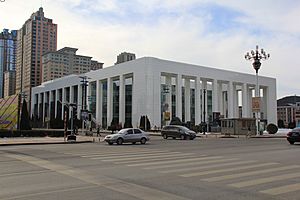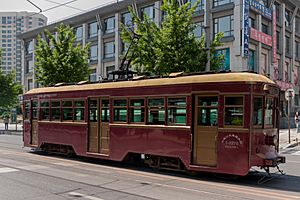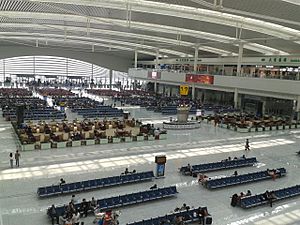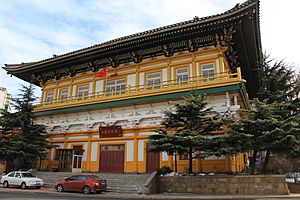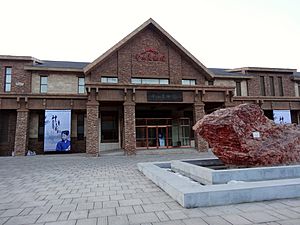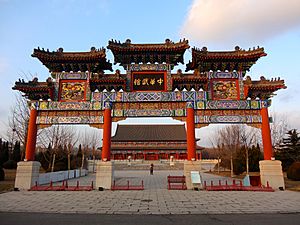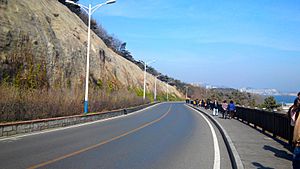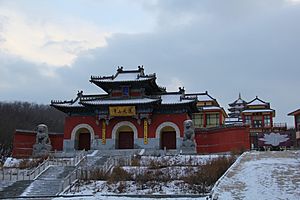Dalian facts for kids
Dalian (simplified Chinese: 大连; traditional Chinese: 大連; pinyin: Dàlián) is an important port city in the Liaoning province of China. It is located on the Liaodong Peninsula. It is the northernmost warm water port in China as well as the southernmost city in Northeast China. The name of the city translates into "Great Link", due to its strategic location on the coast of the East China Sea since it is used for trade with countries like Russia, the North and South Korea, and Japan.
Contents
History
Ancient
In the Qin and Han periods (221 BC–AD 220), Chinese expanded their territories into northern Korea through the Dalian region, then under the jurisdiction of Liaodong county. During the Sixteen Kingdoms era (3rd through 5th centuries), the kingdom of Goguryeo controlled this region. In the early Tang Dynasty (618–907), the Dalian region was part of Andong Prefecture in Jili state; during the Liao Dynasty (916–1125), it was part of Dong Jing Tong Liaoyang county. Dalian was named Sanshan in the period of Wei Jin (220–420), San Shanpu in the Tang Dynasty (618–907), Sanshan Seaport in the Ming Dynasty (1368–1644), and Qingniwakou during the Qing Dynasty (1644–1911).
Qing Dynasty
In the 1880s, Jinzhou, the north of downtown within Dalian, now Jinzhou District, was a walled town and centre for political intrigue and economic activity. The Qing government built bridges and heavily fortified the peninsula. Mining camps on the northern coast of Dalian Bay became the small town of Qingniwa or Qingniwaqiao, near what became downtown Dalian.
British, Russian, and Japanese occupations
The British occupied Qingniwa in 1858, but it returned to Chinese control in the 1860. Port Arthur at the peninsula's tip took its English name from Royal Navy Lieutenant William C. Arthur, but Chinese called it Lüshun. Although China heavily fortified the area, in which it allowed trade with foreigners, Japan swiftly overcame those defenses in the First Sino-Japanese War, committing the Port Arthur massacre during the war in November 1894. In April 1895, China conceded defeat in the First Sino-Japanese War, ceding Liaodong Peninsula, Taiwan and Penghu, and making many other concessions in the Treaty of Shimonoseki.
The Triple Intervention by Russia, France and Germany forced Japan to return the Liaodong Peninsula to China, despite the treaty's terms; instead the Russian Empire coerced a lease of the peninsula from the Qing Dynasty in 1898. For Russia the region of the peninsula was of particular interest as one of the few areas in the region that had the potential to develop ice-free ports. The Russians built a modern commercial port city, which they wanted to become the Paris of the Far East, and called it Dal'niy (Russian: Дальний). Linked to the Trans-Siberian Railway's branch line from Harbin, Dalniy became Russia's primary port-city in Asia, and also served other western traders. Russia signed the Pavlov Agreement (1898) with China, which granted Russia a 25-year lease on Dalian and Lüshun and exclusive right to lay a branch of the Chinese Eastern Railway—what would become the South Manchurian Railway. Russia spent more than 10 million golden rubles (equivalent to 11.5 billion of today's rubles) building the new ice-free port city.
Russia heavily fortified both Dalniy (Qingniwaqiao of Zhongshan District) and the Port Arthur naval base (Lüshunkou) before and after the Boxer Rebellion. Missionaries and converts were killed in the peninsula during the insurrection, although the massive massacres of ethnic Chinese Christians including Metrophanes, Chi Sung occurred at Harbin. Also, Western expeditionary forces suppressed the Boxers across the Yellow Sea in Shandong.
During the Russo-Japanese War, the peninsula became a major battleground. Major-General Baron Anatoly Stoessel defended the siege of Port Arthur, for five months, but the Japanese army managed to sink several Russian ships attempting to relieve him through long-distance fire in early December. Admiral Eugene Alexeyeff was blamed for splitting precious resources shipped 5,000 miles (8,047 km) across the single tracked Trans-Siberian Railway and Manchurian Railway between Dalniy and Port Arthur. After the Japanese navy crippled the remaining Russian battleship Sevastopol in three weeks of constant attacks, and explosives detonated in tunnels destroyed Port Arthur's remaining defenses at year's end, Russia surrendered the port on 2 January 1905.
The Treaty of Portsmouth ceded Port Arthur to Japan, which set up the Kwantung Leased Territory or Guandongzhou (關東州), on roughly the southern half (Jinzhou District and south) of present-day Dalian. Japanese invested heavily in the region, which became the main trading port between Manchuria and Japan. Japan leased the area from Manchukuo after establishing the puppet state in 1932. In 1937, as the Second Sino-Japanese War began, Japan enlarged and modernized the trade zone as two cities: the northern Dairen (Dalian) and the southern Ryojun (Lüshun or Port Arthur).
Post-World War II
With the unconditional surrender of Japan in August 1945, Dairen was passed to the Soviets, whose Manchurian Strategic Offensive Operation had liberated the city. The Soviets and Chinese Communists cooperated to develop the city, relatively undamaged during the war, especially its industrial infrastructure and the port. The Soviet government rented the port and in 1945 the first Chinese Communist mayor of the new Lüda Administrative Office (Chinese: 旅大行政公署) had been appointed.
In 1950, the USSR presented the city to the Chinese Communist government without any compensation. Dalian and Lüshun (former Port Arthur) merged as Lüda on 1 December 1950. From 12 March 1953 to 1 August 1954 it was a direct-controlled municipality and not part of Liaoning. Soviet troops left the city in 1955. After the Soviets left, the PRC made Lüda a major shipbuilding centre.
In 1981, it was renamed Dalian, with Lüshunkou becoming a constituent district. In 1984, the Chinese Government designated the city a Special Economic Zone. At the time, Dalian was China's largest foreign trade port.
Post 1990
The city was upgraded from a prefecture-level city to a sub-provincial city in May 1994, with no change in its administrative subdivisions. In the 1990s the city benefited from the attention of Bo Xilai (later Communist Party head of Chongqing) who was both the mayor of the city and one of the major leaders in the province, who, among other things, banned motorcycles and planted large, lush parks in the city's many traffic circles. He also preserved much of Dalian's Japanese and Russian architectural heritage. He also worked as former Minister of Commerce of the PRC.
In 2008, about 1,000 people protested and blocked traffic as a response of the 2008 Tibetan anti-Chinese protests, and forced the temporary closure of the local Carrefour store.
In 2010, one of the worst recorded oil spills in China's history occurred in Dalian.
Since 2007, Dalian has been hosting the Annual Meeting of the New Champions ("Summer Davos"), organised by the World Economic Forum, in alternating years with Tianjin. The venue for the forum is Dalian International Conference Center in Donggang CBD.
Post 2010
- 14 August 2011 - Dalian PX protest occurred.
- June 2014 - China's tenth national new area, Dalian Jinpu New Area officially established.
- 14 June 2016 - Dalian taxi incident occurred.
- 5 August 2016 - Dalian Huabiao incident occurred.
Geography
One of the most heavily developed industrial areas of China, Dalian municipal area today consists of Dalian proper and the smaller Lüshunkou (formerly Lüshun city, known in Western and Russian historic references as Port Arthur), about forty nautical miles (74 kilometres; 46 miles) farther along the Liaodong Peninsula. Historical references note that the Russian designed city of Dalniy (Alt. Dalney), on the south side of Dalian Bay was 40 kilometres (25 miles) from Port Arthur/Lüshun (known today as Lüshunkou or literally, Lüshun Port).
Dalian is located on Korea Bay north of the Yellow Sea and roughly in the middle of the Liaodong peninsula at its narrowest neck or isthmus. With a coastline of 1,906 km (1,184 mi), it governs the majority of the Liaodong Peninsula and about 260 surrounding islands and reefs. It is seated at south-south-west of the Yalu River, and its harbour entrance forms a sub-bay known as Dalian Bay.
Climate
Dalian has a monsoon-influenced humid continental climate (Köppen Dwa), characterised by warm wet summers due to the East Asian monsoon, and cold, windy, dry winters that reflect the influence of the vast Siberian anticyclone. Except for winter, the city experiences a one-month seasonal lag due to its position on the Liaodong Peninsula. The monthly 24-hour average temperature ranges from −3.9 °C (25.0 °F) in January to 24.1 °C (75.4 °F) in August. Annual precipitation averages 602 millimetres (23.7 in) but is heavily concentrated in the summer months and can vary greatly from year to year. Due to the coastal location, the mean diurnal temperature variation annually is small, at 6.75 °C (12.2 °F). The monthly percent of possible sunshine ranges from 49% in July to 68% in September and October, with 2,740 hours of bright sunshine annually. The annual mean temperature is 10.90 °C (51.6 °F). Extremes since 1951 have ranged from −21.1 °C (−6 °F) on 4 January 1970 to
Environmental issues
In 2001, The United Nations Environment Programme awarded the Dalian Municipal Government for its outstanding contribution to the protection of the environment.
The average content of the four pollutants in the air reached Class Ⅱ of National Ambient Air Quality Standards and there were 353 days with Air Pollution Index (API) over Class Ⅱ (Good), including 108 excellent days with Class Ⅰ (Superior). Dalian frequently ranks Grade 2 for air pollution according to State Environmental Protection Administration. However, the environmental effects of economic growth are of concern, according to Dalian Environmental Protection Agency, during the first half of 2011, respirable particles in the air increased significantly, with an average 40% higher than 2010.
The water quality of offshore marine space remained stable overall. The annual average content of monitoring indicators for water quality met Class-II of the National Seawater Quality Standard, with the exception of Inorganic Nitrogen in Dalian Bay and the city's southern coast. The water quality of drinking water sources is considered good and complies with Class-III of Environmental Quality Standards for Surface Water.
Administration
Dalian is the second largest city of Liaoning province, after Shenyang, the provincial capital. Dalian City is governed by the Dalian Municipal People's Government.
Municipal government
The municipal government is located in the main building on the north side of People's Square on Zhongshan Road, originally built as the Administrative Office of Kwantung Leased Territory, and other buildings in downtown Dalian. There are the Commerce, Foreign Economy & Trade, Hygiene, Information Industry, Police, Religion, Science & Technology, Transportation and other city-level bureaus, which work closely with the corresponding agencies at the district level.
There are, in addition, 4 national leading open zones (Chinese: 对外开放先导区):
- The Development Zone (开发区)
- The Free Trade Zone (保税区)
- The Hi-Tech Industrial Zone (高新技术产业园区)
- The Jīnshítān ("Golden Pebble Beach") National Holiday Resort (金石滩国家旅游度假区)
Demographics
The population of Dalian according to the 2010 census totaled 6.69 million. The total registered population on household at year end 2014 was 5.943 million, with a net increase of 29,000 over the previous year.
Economy
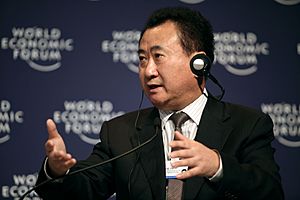
The city has had a continuous annual double-digit percentage increase in GDP since 1992. In 2014, the city's GDP registered a 5.8% increase, reaching RMB 765.56 billion, while per capita GDP hit RMB 109,939. According to a nationwide appraisal by the National Bureau of Statistics, Dalian ranks eighth among Chinese cities in terms of overall strength. The city’s main industries include machine manufacturing, petrochemicals and oil refining, and electronics.
Agriculture and aquaculture
Dalian was originally an agriculture and aquaculture-based area, which, after the opening of the ferry between Yantai and Lüshun during the early 20th century, began to be populated by the farmers and fishers of Shandong, across the Yellow Sea during the Chuang Guandong (闯关东) era.
Heavy, light and distribution industries

Even before and during the Second Sino-Japanese War, the shipbuilding and locomotives industries were located in the city such as the companies which later became Dalian Shipbuilding Industry Company and CNR Dalian Locomotive & Rolling Stock Works (DLoco). After the WWII, Dalian became an important centre of the heavy and light industries, including companies such as Dalian Heavy Industry Co., Dalian Chemical Group, and Wafangdian Bearing Co.; and of the distribution industry, such as the Dashang Group.
Dalian Port is an important port for international trade. It has established trading and shipping links with more than 300 ports in 160 countries and regions of the world. There are over 100 international and domestic container shipping routes. A harbor for oil tankers (the largest by tonnage in China), at the terminus of an oil pipeline from the Daqing oilfields, was completed in 1976. Dalian is the 6th largest port in China; and according to AAPA world port ranking data, Dalian is the 8th busiest port in the world by cargo tonnage in 2012, and the 12th busiest container port in the world by total number of TEUs handled in 2013. Accordingly, Dalian is a major center for oil refineries, diesel engineering, and chemical production.
Also completed in 1993 is a newer port called Dàyáowān Port (大窑湾港), on Dàgūshān (大孤山) Peninsula in the northern suburbs, specialising in import-export of mining and oil products. Together with the Dalian Railway Station, Dalian North Railway Station, Dalian International Airport and two major express roads to Shenyang (Shenda Expressway), Changchun (Changda Expressway), Harbin (Hada Expressway) in the north and to Dandong to the east, Dalian has been an important distribution centre.
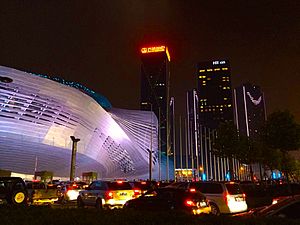
Industrial zones
Dalian has been given many benefits by the Chinese government, including the title of "open-city" (1984), which allows it to receive considerable foreign investment (see Special Economic Zone). The Development Zone was established in Jinzhou District, to which many Japanese companies, such as Canon, Mitsubishi Electric, Nidec, Sanyo Electric and Toshiba, followed by South Korean, American and European companies (such as Pfizer). In 2007, Intel announced plans to build a semiconductor fabrication facility (commonly known as a fab) in the Development Zone, Dalian. It is Intel's first fab to be built at an entirely new site since 1992. The facility began operation in October 2010. Dalian also houses auto-manufacturing plants for Chery, Dongfeng Nissan Passenger Vehicle Company, and BYD Automobile (a production base for BYD K9 electric buses).
Other zones in the city include the Dalian Economic and Technological Development Zone, Dalian Export Processing Zone, Dalian Free Trade Zone, and Dalian Hi-Tech Industrial Zone.
IT industry
Since the 1990s, Dalian has emphasized the development of the IT industry, especially in Dalian Hi-Tech Zone and Dalian Software Park in the western suburbs near Dalian University of Technology. Dalian High-Tech Zone is the base of high-tech industries, housing more than 4,700 enterprises, including 80 Fortune Global 500 companies. Not only Chinese IT companies, such as DHC, Hisoft and Neusoft Group, but also American, European, Indian and Japanese IT companies are located there, including Infosys, IBM, Dell, HP, Ericsson, Panasonic, Sony, Accenture, Oracle, Hitachi and Cisco. Nine professional business incubators are also located in the area, including the Hi-tech Business Incubator, animation and software incubators, with over 400 companies incubated. Currently, the "Lüshun South Road Software Industry Belt" Plan is proceeding, including Dalian Software Park Phase 3.
Intel's Fab 68 is located in Dalian. The plan was announced on 26 March 2007, and operations started on 26 October 2010. It is Intel's first chip-manufacturing fabrication in East Asia.
Tourism
Dalian is a popular destination among domestic tourists and foreign visitors, especially from Japan, South Korea and Russia. Its mild climate and multiple beaches as well as its importance in the modern history of China have attracted tourists. Some of the most famous beaches are Jīnshítān Golden Coast (Chinese: 金石滩黄金海岸) beach, Fùjiāzhuāng (Chinese: 付家庄) beach, Bàngchuídǎo (Chinese: 棒棰岛) beach, Xīnghǎi Park (Chinese: 星海公园) beach, Xīnghǎi Bay (Chinese: 星海湾) beach, and Xiàjiāhézi (Chinese: 夏家河子) beach. In 2007, it was one of the three cities named "China's best tourist city", along with Hangzhou and Chengdu, recognized by the National Tourism Administration and the United Nations World Tourism Organization.
Four inner-city districts
- Zhongshan Square
- Originally designed by Russians in the 19th century, Zhongshan Square (中山广场) is especially noted for the several classical buildings located around the square built during the first half of the 20th century by the Japanese.
- Laohutan Ocean Park: the park contains the Polar Region Marine Animals World, the Coral Aquarium, and the World of Birds. The white whale and dolphin show is a major attraction in the Polar Region Marine Animals World. The Tigers Sculpture Square is nearby, whose tiger sculpture is the symbol of Tiger Beach (Chinese: 老虎滩; pinyin: Lǎohǔtān). A retired Anshan-class destroyer Taiyuan is open to visitors.
- Xinghai Square: situated at the Xinghai Bay, Xinghai Square (Chinese: 星海广场; literally "Square of the Sea of Stars") was built at the centennial of the City of Dalian (1998) and is the largest city square in the world.
- Hēishíjiāo Geological Park and Dalian Natural History Museum
- Sunasia Ocean World
- Dalian Forest Zoo
- Bangchuidao Scenic Area: a well-maintained park used as a State Guesthouse since 1960, the Bangchuidao Scenic Area is now open to the public with upgraded features including lavish greens, Chinese and western style villas, hot spring, tennis courts, badminton courts, a recreation center, a golf course and the Bangchuidao beach. The Bangchui Island (Chinese: 棒棰岛; pinyin: Bàngchuí Dǎo, named for an islet in the shape of an ancient washing tool Bangchui) can be seen from the beach. As a State Guesthouse, the scenic area has received numerous Chinese and foreign leaders and high profile officials, including Zhou Enlai, Deng Xiaoping, Jiang Zemin, Hu Jintao, Henry Kissinger, Boris Yeltsin, Gerhard Schröder, Juan Antonio Samaranch and so on.
- Dalian Sightseeing Tower
- Dōnggǎng Music Fountain
- Fùjiāzhuāng
Hot Spring and Ski Resorts
There are various hot spring hotels in Dalian. Notable ones include, Laotieshan Hot Spring Hotel in Lüshun, Tang Dynasty Hot Spring Resort in Jinshitan, Minghu Hot Spring Hotel in Wafangdian City, Chengyuan Hot Spring Villa in Ganjingzi District, and Tianmu Hot Spring Hotel in Lüshun.
Skiing has become increasingly popular in Dalian. Famous ski resorts are, Linhai Ski Resort in Ganjingzi District, Anbo Ski Resort in Pulandian District, Minghu Ski Resort & Minghu International Skiing Holiday Village in Wafangdian City, and Dalian Happy Snow World in Ganjingzi District near the airport.
Transportation
Local transportation
Not many people ride bicycles in Dalian because of the hilly roads. Dalian is also one of the many cities in China where there are few motorcycles, because motorcycle riding on most roads is banned by law. The city has a comprehensive bus system and an efficient metro system. As of November 2015, the Dalian Metro consists of the underground Line 1, Line 2, and the overground Line R2 and Line 3. New lines and expansion of the metro system are under way. The Dalian Tram system is the second oldest in China. Most of the public transportation in the city can be accessed using the Mingzhu IC Card (Chinese: 明珠卡).
Domestic and international
In 2005 Dalian expanded the international airport, Dalian Zhoushuizi International Airport, with direct flights to the most major cities in China, and to some cities in Japan, South Korea and Russia. In 2014, the airport was the 20th busiest airport in China with 13,551,223 passengers. The airport is the hub of Dalian Airlines.
The city's location means that train trips to most Chinese cities outside China's northeastern region require changing trains in Beijing or Shanghai. With the high-speed rail system, trips from Dalian to Shenyang can be completed in 1.5 hours, to Changchun 2.5 hours and to Harbin 3.5 hours. The city has two railway stations, namely Dalian Railway Station and Dalian North Railway Station (IATA: DBL), the latter being part of the Harbin–Dalian High-Speed Railway.
In addition to local and express bus services to Beijing and other areas in the northeast, Dalian is connected by passenger ship service to neighbouring coastal cities, including Tianjin, Yantai, Weihai, Penglai and Dongying, as well as Incheon, South Korea.
Culture
In 2006, Dalian was selected as the most liveable city in China according to China Daily.
Cuisine
Dalian cuisine is a branch of Shandong cuisine, with influence from Northeastern Chinese cuisine, and is widely known for its unique style of seafood dishes. The variety of seafood in Dalian includes fish, prawns, clams, crabs, scallops, sea urchins, oysters, sea cucumbers, mussels, lobsters, conches, abalone, algae, razor clams, urechis unicinctus, mantis shrimps, jellyfish and so on. During the winter, many seafoods such as clams, mussels and abalone gain the most fat.
Colorful snowflake scallops (Chinese: 五彩雪花扇贝) is a local seafood dish, where egg white is made into snowflake-shape to embrace the scallops, with seasonal greens, carrot and hot pepper cut into small pieces as decorations on top.
Another popular local dish is Salted fish with corn cake (Chinese: 咸鱼饼子), where steamed or fried corn cake is served with fried salted fish. Legend goes that, in the old days fishermen going out fishing in the morning couldn't return home to have lunch, so they baked fresh fish to eat with corn cakes, and the habit passed down from generation to generation and eventually became a famous food among local people.
Dalian Menzi (Chinese: 焖子) is a traditional local snack. A protein-rich starch paste coagulated from an extract of potatoes is cut into pieces and fried on a pan to create a crisp cover. A mixed seasoning of smashed garlic, sesame, and sauces is added on eating.
Other popular local specialties include Dalian-style grilled squid, seafood noodles, roast full prawns, salt baked conches, lantern-shaped steamed abalone, and so on.
Sports
Sports play a big role in the local culture. Dalian's former association football club, Dalian Shide (formerly known as Dalian Wanda as the club was originally sponsored by the Dalian Wanda Group), achieved a total of eight titles from China's top-tier football league, the Chinese Jia-A League and the later rebranded Chinese Super League, and was widely considered one of the most successful clubs in Chinese football history. In the Asian Football Confederation, the club reached the 1997–98 Asian Club Championship and 2000–01 Asian Cup Winners' Cup finals. Several of China’s greatest players, including Sun Jihai, Hao Haidong and Li Ming, made their names with Dalian Shide. Dalian also produced many top Chinese football players thanks to its youth training system and grassroots football culture. As of the 2014 season of the Chinese Super League, out of the 448 registered Chinese players, a total of 71 players are from Dalian. Therefore, Dalian earned its nickname of China's "Football City" (Chinese: 足球城), and a giant football statue was placed in the Labor Park near downtown Dalian in its honor. Current football clubs in the city are Dalian Yifang and Dalian Transcendence, which play in the country's 2nd-tier league, the China League One. Their home stadiums are Dalian Sports Center Stadium and Jinzhou Stadium, respectively.
Some other popular sports played in Dalian are swimming, skiing, golf, cycling, bowling and billiards. The government hold various events every year in Dalian, like marathon, tennis and so on.
As part of the 2013 National Games of China in Liaoning in 2013, Dalian was a host city for 12 events, including synchronized swimming, field hockey, gymnastics, sailing and canoeing.
City-wide festivals and events
Xinghai Square, Dalian Xinghai Convention & Exhibitions Center, the Dalian World Expo Center and the hotels on Renmin Road are the main places where Dalian's major annual events are held.
Every year from January to February, the Bingyugou Ice Lantern Festival is held in Bingyugou Scenic Area in Zhuanghe City. The event features a large number of ice sculptures, snow sculptures and colorful ice lanterns. Visitors can also participate in a series of ice-sports including ice-skating, ice hockey and iceboating.
From late April to May, the Lüshun International Cherry Blossom Festival is held. The main site is 203 Hill, and the other site is Longwangtang Cherry Blossom Park. It is said that the very first cherry trees were planted by Japanese soldiers stationed in Lüshun during World War II, in order to ease their homesickness. Today, the 203 Hill site has more than 3000 cherry trees, and boasts to be the largest cherry blossom park in China with the most varieties.
Each May, the Dalian International Walking Festival takes place. The purpose of the festival is to foster health and peace for the whole community. It is widely popular among citizens and attracts many foreign participants. Dalian is the only city in China recognized by the IML Walking Association. Four different routes of 30 kilometres (19 miles), 20 kilometres (12 miles), 10 kilometres (6.2 miles) and 5 kilometres (3.1 miles) are provided for participants, with the longest route going from Xinghai Square along Binhai Road to Laohutan Ocean Park, Bangchuidao Scenic Area and finally reaching Dalian International Conference Center. Starting from 2012, Jinshitan National Holiday Resort also serves as a venue for the festival.
Every May, Dalian International Marathon is held. With the first marathon held in 1987, it is one of the four oldest marathon races in China. The main venue is the Jinshitan National Holiday Resort.
Every June, the China International Software & Information Service Fair is held in Dalian World Expo Center. Officials from overseas government departments, CEOs of World Top 500, well-known consulting firms and overseas IT associations attend the fair each year.
Dalian International Beer Festival takes place in Xinghai Square every year from July to August. It is similar to Oktoberfest in Munich and is a widely popular event in the city. Activities of the Beer Festival include exhibitions by beer manufacturers, a beer disco plaza, a beer culture exhibition, a beer drinking contest, a photography contest, the Beer Industry Summit, and a beer quiz.
Dalian International Automotive Exhibition is held in August in Dalian Xinghai Convention & Exhibitions Center and Dalian World Expo Center.
The annual Dalian International Fashion Festival is held in September in Dalian Xinghai Convention & Exhibitions Center and Dalian World Expo Center. For the past decade, the festival has been attracting the world's top fashion designers, businessmen and models to Dalian. Arrangement for the show includes various theme activities including the Garment Export Fair, fashion exhibitions, fashion competitions and a model contest.
Religion
Dalian had 29 Christian churches (27 of them Protestant, 2 of them Catholic), 10 mosques, 34 Buddhist temples, and 7 Taoist temples, according to the statistics of the city government.
Taoist temples can be found in various districts including downtown Dalian (Hua Temple in Zhongshan Park), in Lüshunkou District (Longwang Temple), and in Jinzhou District (Jinlong Temple in Daweijia, Xiangshui Temple at the foot of Dahei Mountain, and Zhenwu Temple in Liangjiadian).
Buddhist temples are in downtown Dalian (Songshan Temple on Tangshan Street and Lianhuashan Temple on Yingchun Road), on the northern side of Anzi Mountain (Anshan Temple), at Daheishi (Thousand-Hand Buddha & 500 Luohan Statues), in Lüshunkou District (Hengshan Temple at Longwangtang), and in Jinzhou District (Guanyinge-Shengshui Temple on Dahei Mountain).
Dalian Catholic Church (built in 1926) is in downtown Dalian, west of Dalian Railway Station. Protestant churches are near Zhongshan Square (Yuguang Street Church, the former Dalian Anglican Church, built in 1928 in the British Consulate General's premises by the Church of England and Anglican Church of Japan jointly), on Changjiang Road (Beijing Street Church, now called Cheng-en Church, originally built in 1914 by the Danish Lutheran Church), on Xi'an Road (Christian Church for Korean Chinese and South Koreans), east of the airport (the newly built Harvest Church, which can seat 4000 people), in Jinzhou (the newly built Jinzhou Church) and in Lüshunkou District (Lüshun Church, a former Danish Lutheran church). Dalian Mosque is on Beijing Street.
Images for kids
-
Donggang (Chinese: 东港; literally "East Harbour") CBD houses the Dalian International Conference Center
-
Dalian Institute of Chemical Physics, of the Chinese Academy of Sciences
See also
 In Spanish: Dalian para niños
In Spanish: Dalian para niños



